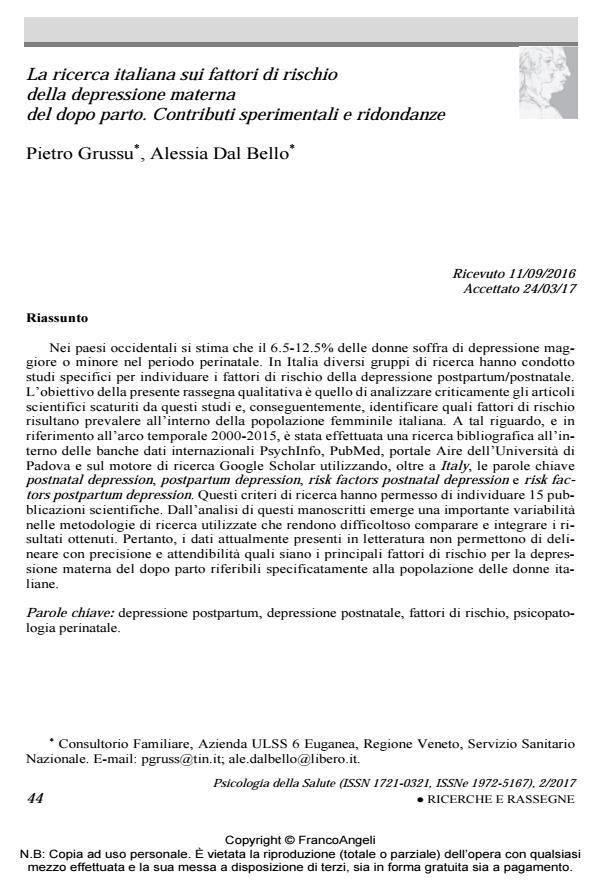La ricerca italiana sui fattori di rischio della depressione materna del dopo parto. Contributi sperimentali e ridondanze
Titolo Rivista PSICOLOGIA DELLA SALUTE
Autori/Curatori Pietro Grussu, Alessia Dal Bello
Anno di pubblicazione 2017 Fascicolo 2017/2
Lingua Italiano Numero pagine 26 P. 44-69 Dimensione file 269 KB
DOI 10.3280/PDS2017-002003
Il DOI è il codice a barre della proprietà intellettuale: per saperne di più
clicca qui
Qui sotto puoi vedere in anteprima la prima pagina di questo articolo.
Se questo articolo ti interessa, lo puoi acquistare (e scaricare in formato pdf) seguendo le facili indicazioni per acquistare il download credit. Acquista Download Credits per scaricare questo Articolo in formato PDF

FrancoAngeli è membro della Publishers International Linking Association, Inc (PILA)associazione indipendente e non profit per facilitare (attraverso i servizi tecnologici implementati da CrossRef.org) l’accesso degli studiosi ai contenuti digitali nelle pubblicazioni professionali e scientifiche
Nei paesi occidentali si stima che il 6.5-12.5% delle donne soffra di depressione maggiore o minore nel periodo perinatale. In Italia diversi gruppi di ricerca hanno condotto studi specifici per individuare i fattori di rischio della depressione postpartum/postnatale. L’obiettivo della presente rassegna qualitativa è quello di analizzare criticamente gli articoli scientifici scaturiti da questi studi e, conseguentemente, identificare quali fattori di rischio risultano prevalere all’interno della popolazione femminile italiana. A tal riguardo, e in riferimento all’arco temporale 2000-2015, è stata effettuata una ricerca bibliografica all’interno delle banche dati internazionali PsychInfo, PubMed, portale Aire dell’Università di Padova e sul motore di ricerca Google Scholar utilizzando, oltre a Italy, le parole chiave postnatal depression, postpartum depression, risk factors postnatal depression e risk factors postpartum depression. Questi criteri di ricerca hanno permesso di individuare 15 pubblicazioni scientifiche. Dall’analisi di questi manoscritti emerge una importante variabilità nelle metodologie di ricerca utilizzate che rendono difficoltoso comparare e integrare i risultati ottenuti. Pertanto, i dati attualmente presenti in letteratura non permettono di delineare con precisione e attendibilità quali siano i principali fattori di rischio per la depressione materna del dopo parto riferibili specificatamente alla popolazione delle donne italiane.
Parole chiave:Depressione postpartum, depressione postnatale, fattori di rischio, psicopato-logia perinatale.
- Perinatal mental health around the world: priorities for research and service development in Italy Pietro Grussu, Ilaria Lega, Rosa Maria Quatraro, Serena Donati, in BJPsych International /2020 pp.8
DOI: 10.1192/bji.2019.31
Pietro Grussu, Alessia Dal Bello, La ricerca italiana sui fattori di rischio della depressione materna del dopo parto. Contributi sperimentali e ridondanze in "PSICOLOGIA DELLA SALUTE" 2/2017, pp 44-69, DOI: 10.3280/PDS2017-002003